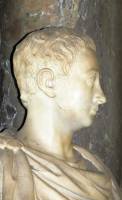
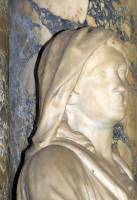
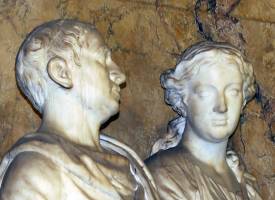
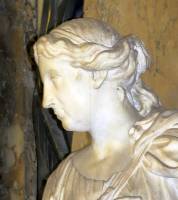
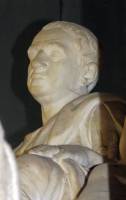
The principal building in High Wycombe is the Parish Church of All Saints, and the principal monument within the Church is that to Henry Petty, Earl of Shelburne, and his family. Monuments do not come much nobler than this. We see a grand architectural structure, like a theatre or diorama, with the Earl (d.1751) and his wife Arabella (d.1740) in central position, reclining on a sarcophagus in front of a tall obelisk. Standing on either side are members of his immediate family. Standing close up, the viewer feels as if visiting the family at home, for they are in relaxed and familial poses. Medieval monuments in Britain generally show an effigy lying down, stiffly, and by Elizabethan times the deceased would generally be found kneeling, still stiffly, husband and wife facing each other and praying in the well-known kneeler monuments. But later years gave both a more naturalistic style, akin the Hellenistic sculpture, and more informal poses, to show the deceased as they were in daily life, rather than in worship or sleep or death. For great personages such as the Earl and his wife, it seems appropriate to find them reclining like noble Romans in their living room, their younger relations ranged on either side, as if giving audience to the viewer, who completes the conversational circle but is placed somewhat lower down.
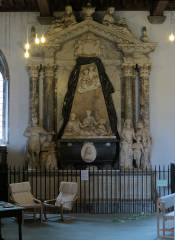 Earl of Shelburne Monument, by Peter Scheemakers, 1754.
Earl of Shelburne Monument, by Peter Scheemakers, 1754.
Higher up are allegorical figures: a cloud with two cherubs (though they have been suggested as the infant children of the Earl), and right at the top, two seated females. They are Justice and Prudence, and these characteristics of the Shelburne family are augmented by the grandeur, richness and solidity of the architectural surround, with its polished marble pillars, Corinthian capitals, flaming urns, and the righteousness and statue embodied by the coat of arms within the pediment.
Two views of the Earl of Shelburne and Arabella, his wife.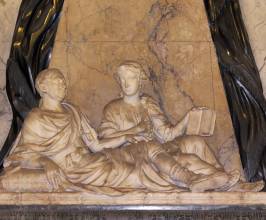
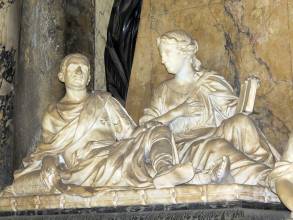
Henry Petty, the Earl, and Lady Arabella his wife, form a well-matched Classical pair, seated together on a padded mattress in a harmoniously composed group. He lounges propped up on one arm, resting on a cushion, his other arm along his thigh and resting above the knee of one outstretched leg. Parallel to this is one arm of Lady Arabella; her other arm props up an open book on her knee. Thus their arms lie in a diagonal band across the group, their feet lie close together, their heads also turn a little towards each other, with each element demonsrating the closeness between the couple.
The Earl is the older of the two, of Senatorial middle age and dignity, dressed Roman civic cloak over a toga-like garment, with Roman sandals too, and close-cropped hair in the style of the Caesars. Lady Arabella is more youthful, a girlish rather than matronly figure with smooth skin and youthful vigour to face and arms. Ostensibly Classical in form, with columnar neck, Roman hairstyle, calm, expressionless face, the chin and nose make this an English rather than Classical depiction of womanhood.
Beneath the figures on the sarcophagus is a roundel with a relief carving of Henry Petty's father, Sir William Petty. Here we have a figure of 18th Century romance, with his long, curled hair and youthful, rather androgenous face, a stylised Arcadian shepherd rather than a member of the English aristocracy.
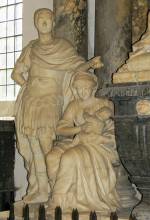
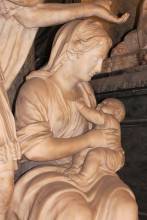 Viscount Dunceron and wife Elizabeth, and son.
Viscount Dunceron and wife Elizabeth, and son.
The group on the left as we look at the monument are James, Viscount Dunkeron (d.1750/51), his wife Elizabeth (d.1742), and infant son, also d.1742. Excellent figures again. James was the first son of Henry Petty, and is shown in Roman toga, cloak swept back, standing in a subtle contrapuncto pose, hips and shoulders slightly opposed, and with an equally slight turn between the left facing legs and forward facing body, the head then turning round and inwards to the centre of the monument, carried further in the motion of his outstretched hand. Elizabeth is seated, absorbed in her infant son, clasped to her chest, epitome of 18th Century motherhood and a charmingly intimate portrait. Separated, each figure would be well on its own, he perhaps on a pedestal in the town centre, she with the infant in a niche in an interior, and together they form a triangular group, with a pleasing line of drapery from the apex of his head, down his upper arm, then along her arm and through to her long skirts. While the drapery has complex folds, the group is divided up into fairly large surfaces, each consistent within itself: the bow-shaped lines of the cloak across his upper chest, the straight vertical lines of his toga, the relaxed dropping folds of his cloak behind his back, and the drapes across her legs.
Julia, Anne and Charles, different views.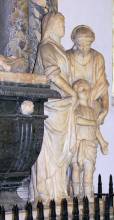
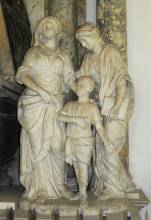
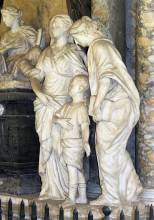
To the right hand side of the monument are the Earl’s daughters, Julia (d.1719), and Anne (d.1727), and their much younger brother, Charles (d.1717). The sisters are beautiful Classical girls, dressed in enveloping drapes, formed into an upper sleeved garment in she on the left, with outer drape forming a skirt held at the waist. She on the right has her cloak over her shoulders and arms, and a lighter garment underneath with a thin belt. With elegant, swaying bodies whose lines are emphasised by the folds of the drapery, filled with movement, the two form a protective surround to the much smaller figure of their little brother. He stands in theatrical pose, one arm across the chest, the other downward and outward with open-palmed hand, as if about to bow to his audience. Above, he wears a thin shirt or chemise, and below, a loosely-knotted drape. All three wear sandals.
Above the Earl and Lady Arabella float the pair of cherubs or infants on their cloud. They are of their time, yet it is hard indeed for the modern eye to like them, however skilful the execution of the sculptor. They are all naked, fleshy limbs and bodies, over-large heads, fat wrists and puckered lips between bulging cheeks. Some attempt at an apreciation of sculptured cherubs is on this page.
Higher up, the coat of arms. The supporters of the central shield are a pair of spirited Pegasi; the Pegasus to the right has lost his wings though. Belonging to an earl, we see a coronet above the shield, and then the usual knight's helm with swirly Acanthus leaves as plumes. There is also a beehive, symbol of productive industry more usually associated with commercial houses.
Finally at the very top, too high to see well, unless standing well back, we have a pair of allegorical girls, reclining on the slanting edges of the pediment, next to flaming urns festooned with flowers, beautifully carved. Prudence sits on the left as we look at her, mirror of Truth held in one hand, the snake of Wisdom entwined about her other arm, with its head held within her hand. She is modestly dressed, as we would expect, and her face bears a distinct similarity to that of Lady Arabella below. More examples of allegorical statues of Prudence on this page, and lots of snake sculpture on this page. To the right, Justice, with her scales, made in bronze, and in her other hand what appears to be the pommel of a sword, which would have been pointing straight upwards. More allegorical carvings of Justice on this page, and to explore the full set of allegorical sculptures on this website, start at this page.
Allegorical statues of Prudence and Justice.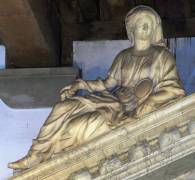
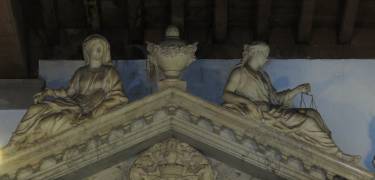
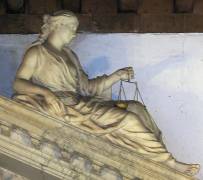
The sculptor, Peter Scheemakers, lived in London from the 1730s through to 1771, when he returned to his home city of Antwerp, and along with J.M.Rysbrack and his own pupil, Joseph Nollekens, had a dominating influence on British sculpture of the time.
The other monuments in All Saints Church, High Wycombe, are noted on this page.
With many thanks to the authorities at All Saints for kind permission to use pictures from inside the Church; see their website at http://www.allsaintshighwycombe.org/heritage.html.
This page was originally part of a 'sculpture of the month' series, for July 2015. Although the older pages in that series have been absorbed within the site, if you would wish to follow the original monthly series, then jump to the next month (Aug) or the previous month (June). To continue, go to the bottom of each page where a paragraph like this one allows you to continue to follow the monthly links.
Sculpture in High Wycombe Church // Other Buckinghamshire Church monuments // Sculpture in England // Sculpture pages
Visits to this page from 1 July 2015: 5,531